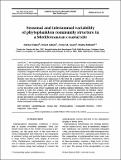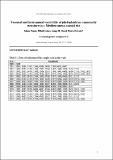Por favor, use este identificador para citar o enlazar a este item:
http://hdl.handle.net/10261/164558COMPARTIR / EXPORTAR:
 SHARE SHARE
 CORE
BASE CORE
BASE
|
|
| Visualizar otros formatos: MARC | Dublin Core | RDF | ORE | MODS | METS | DIDL | DATACITE | |

| Título: | Seasonal and interannual variability of phytoplankton community structure in a Mediterranean coastal site |
Autor: | Nunes, Sdena CSIC ORCID; Latasa, Mikel CSIC ORCID ; Gasol, Josep M. CSIC ORCID ; Estrada, Marta CSIC ORCID | Fecha de publicación: | mar-2018 | Editor: | Inter Research | Citación: | Marine Ecology Progress Series 592: 57-75 (2018) | Resumen: | We studied phytoplankton community structure in surface waters of the fixed coastal station of the Blanes Bay Microbial Observatory (NW Mediterranean Sea). A chemotaxonomic approach based on HPLC analysis of phytoplankton pigments, followed by CHEMTAX algorithm implementation, was applied to a set of monthly samples taken during a 14 yr period (2000-2014). Additional samples were taken for nutrient analyses, flow cytometric measurements and during part of the period for phytoplankton cell counts by optical microscopy. Overall, the most abundant groups in terms of chlorophyll a (chl a) were haptophytes, diatoms and prasinophytes. In general, diatoms were the most important components of the total chl a maxima (T_Chl a). We observed a marked seasonality of T_Chl a and several phytoplankton groups (prasinophytes, diatoms, haptophytes, cryptophytes and pelagophytes) with autumn-winter or winter-spring maxima and summer minima, coinciding with similar variation in major nutrient concentrations. Prochlorococcus presented a fall-winter maximum and a spring-summer minimum, while Synechococcus peaked in April and August, and dinoflagellates were relatively important in summer. Superimposed to this general pattern, prasinophytes and diatoms responded positively to episodic fertilization events associated with freshwater runoff caused by rain storms. Most phytoplankton groups presented a decreasing linear interannual trend that could be associated with a reduction in nutrient availability. A possible driver for this oligotrophication is the improvement of wastewater treatment in the region | Descripción: | 19 pages, 10 figures, 4 tables, supplementary material https://doi.org/10.3354/meps12493 | Versión del editor: | https://doi.org/10.3354/meps12493 | URI: | http://hdl.handle.net/10261/164558 | DOI: | 10.3354/meps12493 | ISSN: | 0171-8630 | E-ISSN: | 1616-1599 |
| Aparece en las colecciones: | (ICM) Artículos (IEO) Artículos |
Ficheros en este ítem:
| Fichero | Descripción | Tamaño | Formato | |
|---|---|---|---|---|
| Nunes_et_al_2018.pdf | 974,87 kB | Adobe PDF |  Visualizar/Abrir | |
| Nunes_et_al_2018_supp.pdf | 348,09 kB | Adobe PDF |  Visualizar/Abrir |
CORE Recommender
SCOPUSTM
Citations
32
checked on 25-mar-2024
WEB OF SCIENCETM
Citations
32
checked on 21-feb-2024
Page view(s)
376
checked on 22-abr-2024
Download(s)
195
checked on 22-abr-2024
Google ScholarTM
Check
Altmetric
Altmetric
NOTA: Los ítems de Digital.CSIC están protegidos por copyright, con todos los derechos reservados, a menos que se indique lo contrario.
